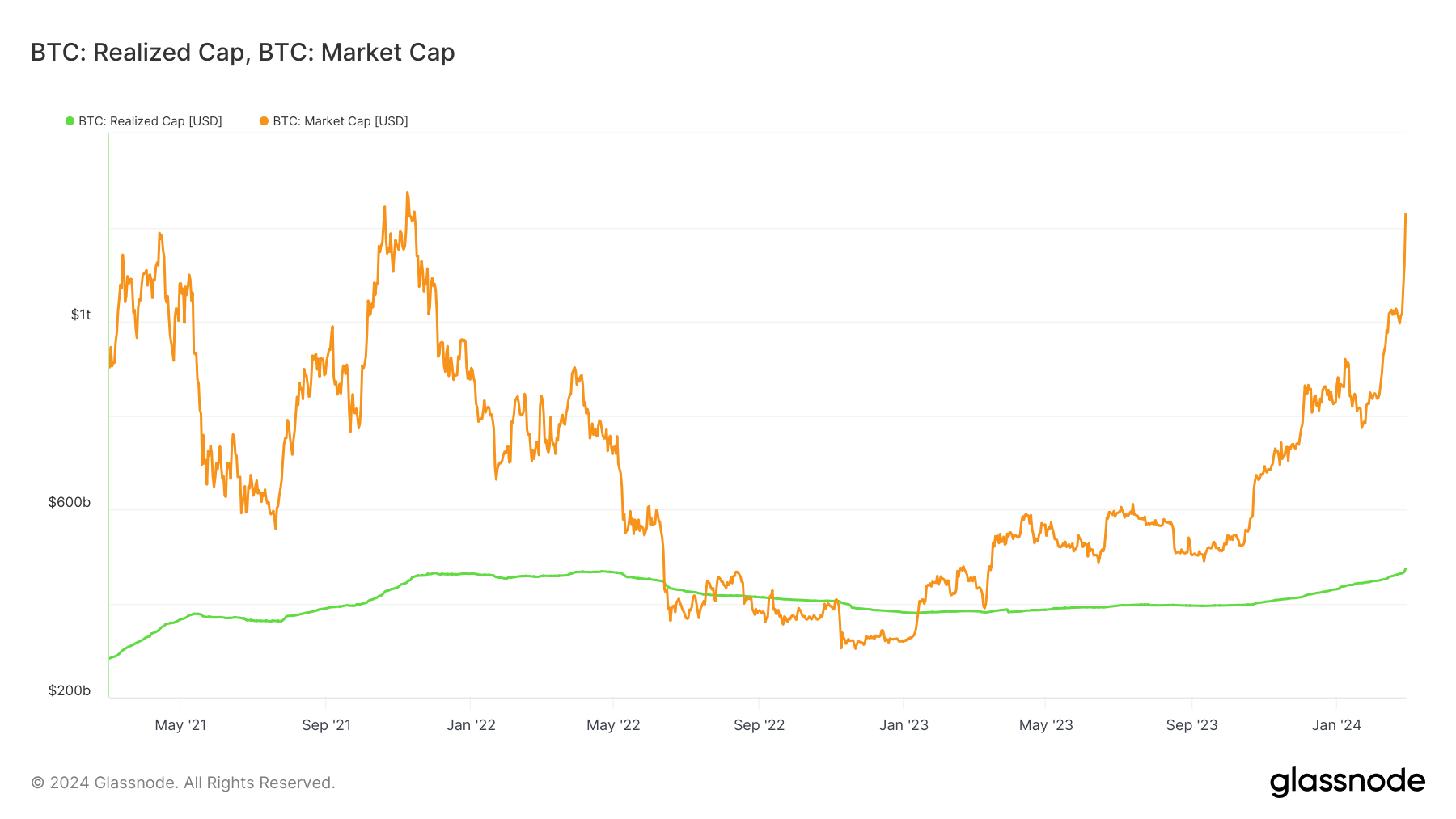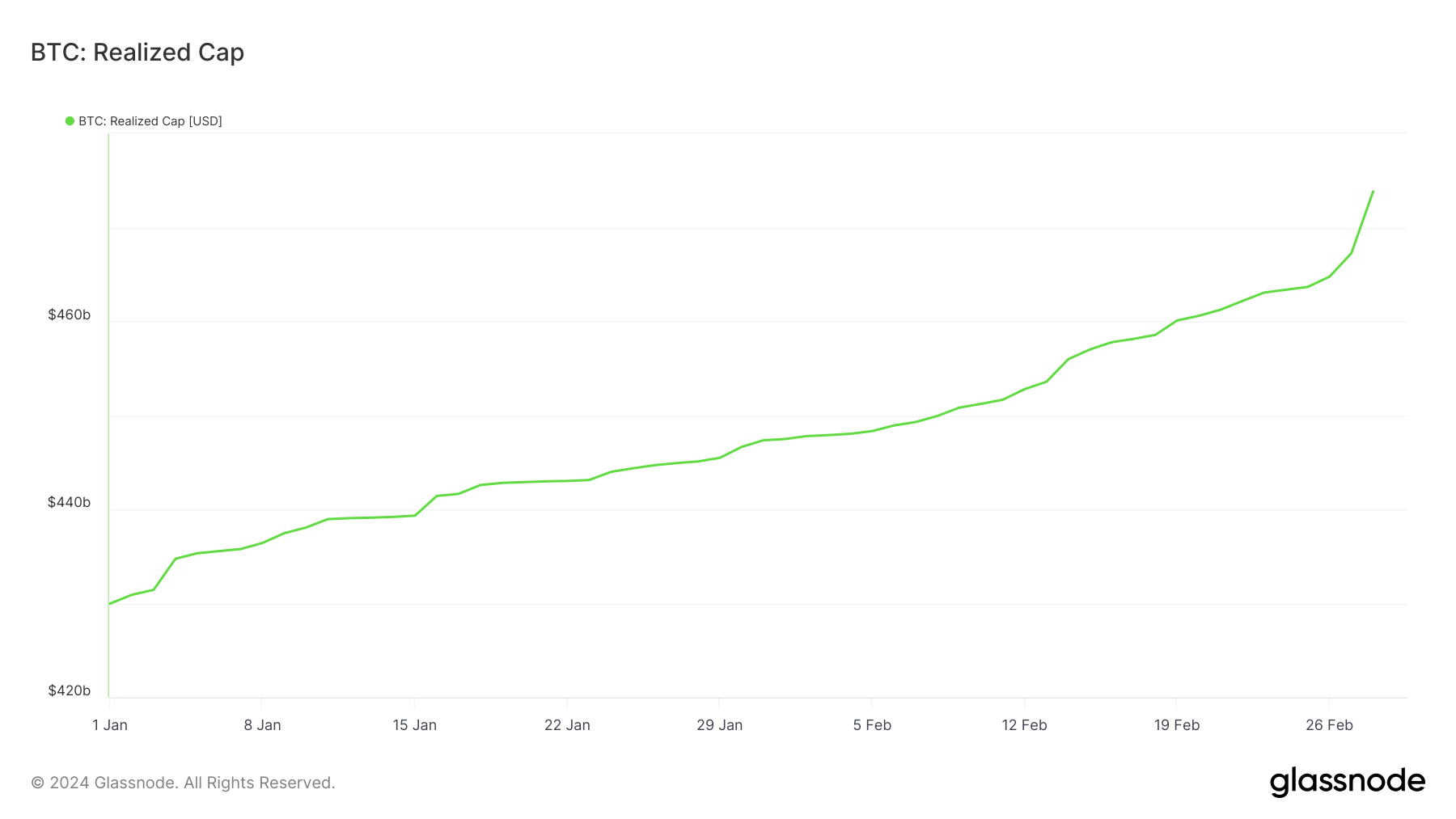Bitcoin’s realized cap is a nuanced and progressive metric for assessing the valuation of Bitcoin that differs considerably from conventional market capitalization.
Not like the market cap, which merely multiplies the present market worth of Bitcoin by the entire variety of cash in circulation, the realized cap affords a extra granular and economically significant perception into the Bitcoin market.
It does this by aggregating the worth of all Bitcoins on the worth they had been final moved quite than the present worth. This method can present a extra steady view of the market’s valuation, much less vulnerable to the volatility related to speculative buying and selling and short-term market actions.
To calculate the realized cap, one should take the worth of every Bitcoin on the time it final moved after which sum these particular person values throughout all Bitcoins. This implies if a Bitcoin was final moved when its worth was $10,000, that particular Bitcoin contributes $10,000 to the cap, whatever the present market worth.
The realized cap reveals issues in regards to the Bitcoin market that aren’t instantly obvious by the market cap.
Firstly, it may well present insights into the funding habits of Bitcoin holders. For instance, a rising realized cap means that Bitcoins are transferring at larger costs, indicating optimistic sentiment amongst buyers. Conversely, a steady or declining realized cap can sign that almost all Bitcoins aren’t altering palms, presumably implying holder conviction or a scarcity of recent funding at larger worth ranges.
Furthermore, it may well function a proxy for the invested capital that’s much less delicate to speculative swings. In intervals of excessive volatility, the market cap can fluctuate wildly, however the realized cap tends to maneuver extra easily, as seen within the graph beneath, reflecting a extra grounded evaluation of the Bitcoin market’s price. This stability makes it a priceless device for buyers seeking to gauge the market’s underlying well being past the noise of each day worth actions.

Bitcoin’s realized cap reached its all-time excessive on Feb. 28, topping at $473.8 billion. This signifies that, on common, the Bitcoin community and its members have by no means been as economically invested in BTC as they’re now, primarily based on the costs at which most Bitcoins had been final transacted.
Reaching an ATH within the realized cap signifies a broadening and deepening of the market’s basis.
Not like market cap, which may quickly inflate with speculative fervor, the realized cap grows because of transactions that replicate precise transfers of wealth and, by extension, a extra sturdy perception in Bitcoin’s worth. Subsequently, this ATH may very well be seen as a extra significant indicator of Bitcoin’s rising acceptance and integration into the monetary portfolios of a wider array of buyers.

The Realized Cap HODL Waves information offers an enchanting perception into the habits of Bitcoin holders and their contribution to the realized cap’s enhance. By analyzing the modifications within the distribution of Bitcoin holdings throughout completely different time-held cohorts previously three days, we are able to decide which group is essentially the most lively and the way their actions influenced the realized cap.
On Feb. 25, the distribution was as follows:
- Bitcoins held for lower than 24 hours accounted for 0.856% of the realized cap.
- Bitcoins held between 1 day and 1 week contributed 5.8%.
- The 1-week to 1-month cohort represented 15.571%.
- Bitcoins held for 3 to six months made up 6.318%.
- The 6-month to 1-year group accounted for 11.818%.
- Lastly, Bitcoins held for 1 to 2 years contributed 12.438%.
By Feb. 28, there was a notable shift:
- The share of Bitcoins held for lower than 24 hours surged to five.828%.
- Holdings between 1-day and 1-week dropped to 4.851%.
- The 1-week to 1-month cohort decreased considerably to eight.543%.
- The three- to 6-month group was barely decreased to six.209%.
- The 6-month to 1-year holdings fell to 11.338%.
- The 1-year to 2-year cohort decreased to 11.975%.

From this information, essentially the most important shift occurred within the under-24-hour cohort, which dramatically elevated from 0.856% to five.828%. This implies a considerable inflow of recent funding or buying and selling exercise, the place a big quantity of Bitcoin modified palms shortly and was possible bought or transferred at larger costs, contributing to the rise within the realized cap. Such short-term holding signifies speculative buying and selling or instant responses to market situations.
The lower in percentages for the 1-day to 1-week and 1-week to 1-month cohorts, alongside slight declines within the longer-term holding classes, suggests a consolidation or a shift from these teams into both the very short-term holding (<24h) resulting from buying and selling or into longer-term holdings not specified right here. This might point out a reallocation of property inside the market, the place some quick to medium-term holders determined to take income or reallocate their investments, contributing to the realized cap enhance.
Subsequently, the rise within the realized cap seems to be considerably influenced by short-term market exercise and buying and selling quite than long-term holding methods, as evidenced by the dramatic enhance within the <24h cohort. Whereas there’s exercise throughout all cohorts, the predominant contribution to the realized cap’s rise on this interval comes from these participating in short-term buying and selling.
This habits displays a market the place worth actions and instant buying and selling alternatives affect the realized cap greater than the buildup methods of longer-term buyers.
The put up Document excessive realized cap exhibits unprecedented financial funding in Bitcoin appeared first on StarCrypto.

